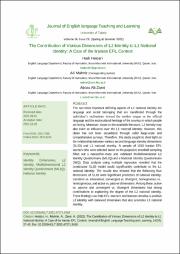| dc.contributor.author | Heidari, Hadi | en_US |
| dc.contributor.author | Malmir, Ali | en_US |
| dc.contributor.author | Zarei, Abbas | en_US |
| dc.date.accessioned | 1401-05-11T20:24:18Z | fa_IR |
| dc.date.accessioned | 2022-08-02T20:24:19Z | |
| dc.date.available | 1401-05-11T20:24:18Z | fa_IR |
| dc.date.available | 2022-08-02T20:24:19Z | |
| dc.date.issued | 2022-05-01 | en_US |
| dc.date.issued | 1401-02-11 | fa_IR |
| dc.date.submitted | 2021-08-01 | en_US |
| dc.date.submitted | 1400-05-10 | fa_IR |
| dc.identifier.citation | Heidari, Hadi, Malmir, Ali, Zarei, Abbas. (2022). The Contribution of Various Dimensions of L2 Identity to L1 National Identity: A Case of the Iranian EFL Context. Journal of English Language Teaching and Learning, 14(29), 27-43. doi: 10.22034/elt.2021.47271.2418 | en_US |
| dc.identifier.issn | 2251-7995 | |
| dc.identifier.issn | 2676-6876 | |
| dc.identifier.uri | https://dx.doi.org/10.22034/elt.2021.47271.2418 | |
| dc.identifier.uri | https://elt.tabrizu.ac.ir/article_14068.html | |
| dc.identifier.uri | https://iranjournals.nlai.ir/handle/123456789/925547 | |
| dc.description.abstract | The two most important defining aspects of L1 national identity are language and social belonging that are manifested through the individual's inclinations toward the mother tongue or the official language and the sociocultural heritage of the country in which people are living. Moreover, based on the available literature, L2 identity may also exert an influence over the L1 national identity; however, this claim has not been securitized through valid large-scale and comprehensive surveys. Therefore, this study sought to shed light on the relationship between various second language identity dimensions (SLID) and L1 national identity. A sample of 1018 Iranian EFL learners who were selected based on the purposive snowball sampling filled out a researcher-made and validated Multidimensional L2 Identity Questionnaire (MLIQ) and a National Identity Questionnaire (NIQ). Data analysis using multiple regression revealed that the constructed SLID model could significantly contribute to the L1 national identity. The results also showed that the following four dimensions of SLID were significant predictors of national identity: transitive vs. intransitive, convergent vs. divergent, homogeneous vs. heterogeneous, and active vs. passive dimensions. Among these, active vs. passive and convergent vs. divergent dimensions had strong contributions to explaining the degree of the L2 national identity. These findings can help EFL teachers and learners develop a positive L2 identity with balanced dimensions that also promotes L1 national identity | en_US |
| dc.format.extent | 1100 | |
| dc.format.mimetype | application/pdf | |
| dc.language | English | |
| dc.language.iso | en_US | |
| dc.publisher | University of Tabriz | en_US |
| dc.publisher | دانشگاه تبریز | fa_IR |
| dc.relation.ispartof | Journal of English Language Teaching and Learning | en_US |
| dc.relation.ispartof | مجله مطالعات آموزش و فراگیری زبان انگلیسی دانشگاه تبریز | fa_IR |
| dc.relation.isversionof | https://dx.doi.org/10.22034/elt.2021.47271.2418 | |
| dc.subject | Identity Dimensions | en_US |
| dc.subject | L2 Identity | en_US |
| dc.subject | Multidimensional L2 Identity Questionnaire (MLIQ) | en_US |
| dc.subject | National Identity | en_US |
| dc.subject | English language learning | en_US |
| dc.title | The Contribution of Various Dimensions of L2 Identity to L1 National Identity: A Case of the Iranian EFL Context | en_US |
| dc.type | Text | en_US |
| dc.type | Research Paper | en_US |
| dc.contributor.department | English Language Department, Faculty of Humanities, Imam Khomeini International University (IKIU), Qazvin, Iran. | en_US |
| dc.contributor.department | English Language Department, Faculty of Humanities, Imam Khomeini International University (IKIU), Qazvin, Iran. | en_US |
| dc.contributor.department | English Language Department, Faculty of Humanities, Imam Khomeini International University (IKIU), Qazvin, Iran. | en_US |
| dc.citation.volume | 14 | |
| dc.citation.issue | 29 | |
| dc.citation.spage | 27 | |
| dc.citation.epage | 43 | |
| nlai.contributor.orcid | 0000-0003-1589-0301 | |





